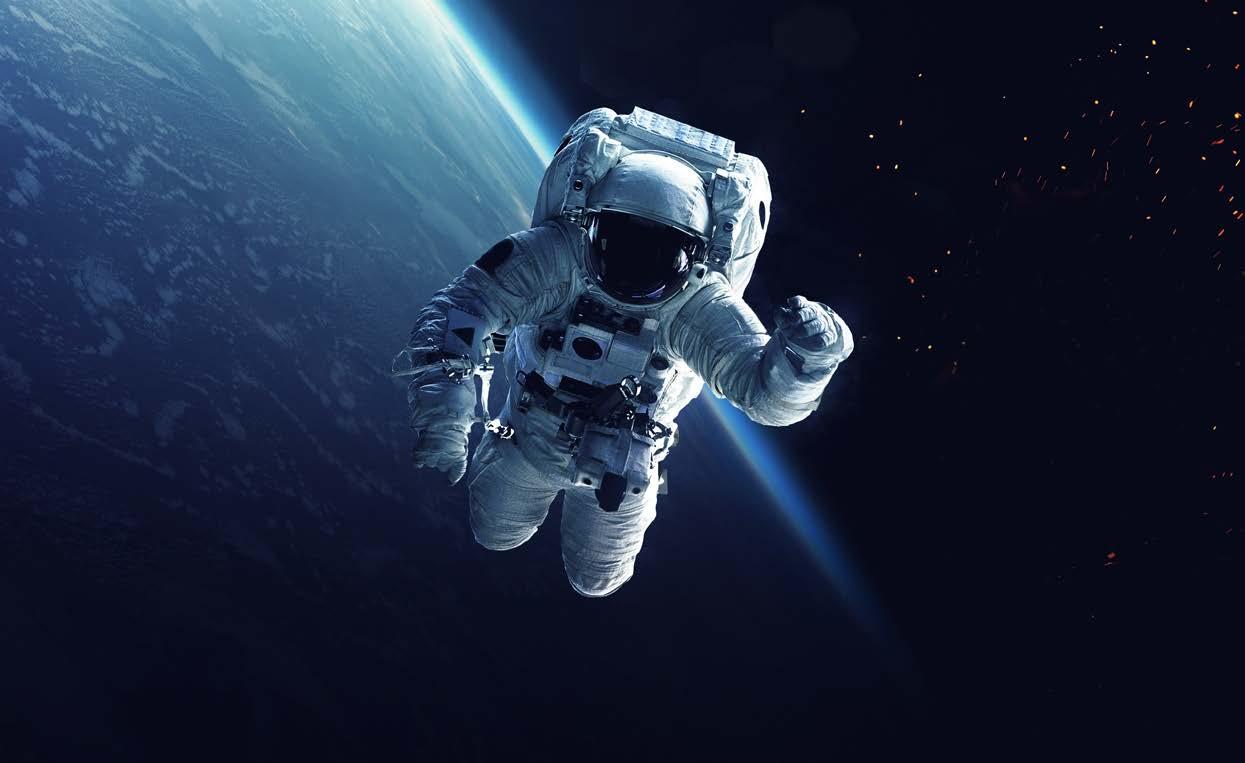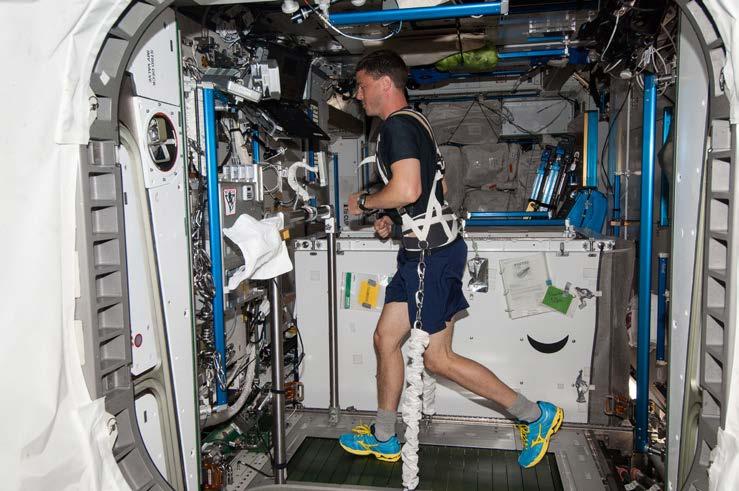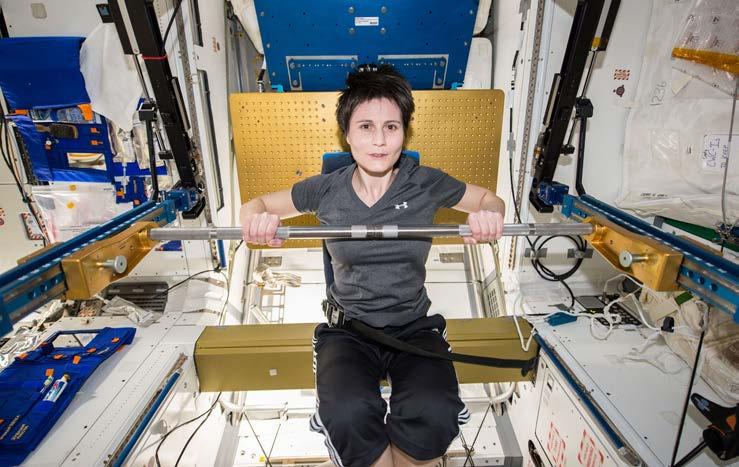
7 minute read
Combating muscle loss in space
Mus musculus: how nanofluidic drug delivery could counter muscle loss in space
Advertisement
Muscle atrophy presents a significant health risk for astronauts, who can lose around 40% of their muscle mass after six months in microgravity.
Astronauts in space have to exercise for an average of two and a half hours per day to minimise the impacts of muscle atrophy in microgravity. This presents a significant health risk for astronauts undertaking long-haul trips into space, such as US astronaut Mike Kelly who spent 342 days aboard the International Space Station from 2015 to 2016.
The mechanical unloading of the muscles in zero-gravity conditions triggers protein synthesis to decrease and protein degradation to occur, causing the muscles to start wasting. It’s the same reason patients with chronic illnesses that leave them immobile or bedridden also experience muscle atrophy.
Scientists at Houston Methodist Institute for Academic Medicine are now working to combat astronauts’ atrophy in outer space, using a subcutaneously implanted nanofluidic drug delivery system. The device is designed to gradually release very small doses of a drug called formoterol and has now been trialled in mice aboard the International Space Station.
Formoterol is a bronchodilation drug, a type of medication that makes breathing easier by relaxing the muscles in the lungs and widening the airways. It’s a long-acting bronchodilator, meaning it’s used as a maintenance treatment to offset the symptoms of chronic lung diseases like asthma, bronchitis or emphysema.
Alongside these effects, formoterol has been shown to stimulate increased muscle mass at certain doses, which could help our astronauts out. However, these doses also lead to cardiovascular side effects – increased heart rate, decreased blood pressure, reduced plasma potassium concentration – which in the harsh conditions of outer space are far from ideal.
Mitigating side-effects through low-dose drug delivery
The Houston researchers are hoping that the systematic low-dose release of formoterol permitted by the nanofluidic delivery system can prevent muscle wastage while avoiding these cardiac side effects.
Houston Methodist professor of nanomedicine Dr Alessandro Grattoni says: “It may be possible that adverse effects of formoterol could be mitigated via low-dose sustained delivery. As opposed to bolus administration, which is typically associated with a ‘rollercoaster’ in drug concentration in the body, sustained low dose delivery may prove effective while limiting side effects. However, this needs to be further investigated.”
“In the study subjects flown on the international space station, we observed an increase in grip strength of 11%.”
A group of mice (Mus Musculus) were fitted with the device and sent to space for 56 days, to test the impact sustained delivery of formoterol had on their muscles when they were in zero gravity. Far from merely preventing atrophy, the drug actually stimulated muscle growth in certain areas.
Grattoni says: “Formoterol was effective a preventing muscle atrophy. In fact, we observed an increase in muscle mass, specifically muscles such as the gastrocnemius, soleus and plantaris, that are relevant in standing and numerous movements. In the study subjects flown on the International Space Station, we observed an increase in grip strength of 11%. This is significant, especially in view of the short duration of the study.”
Nanofluidic delivery could help manage multiple medications
This study is the first demonstration that implantable nanofluidic drug delivery systems could be used to maintain astronaut health in outer space. Theoretically, rather than exercising for several hours every day to offset mechanical unloading, astronauts could receive a sustained supply of formoterol from an implant under their skin. Nanofluidic delivery would help them to avoid a spike in drug levels in their system, meaning they would be able to bypass the negative cardiac side effects and simply sit back and reap the rewards.

Rather than exercising for several hours every day to offset muscular atrophy, astronauts could receive a sustained supply of formoterol from an implant under their skin.

Back on Earth, the drug delivery system has a significant potential for patients affected by muscle atrophy due to ongoing health conditions. For those who are bedridden or immobile, an implanted device like this could be life-changing.
Grattoni also sees applications for the device outside of formoterol delivery for muscular atrophy.
“Implants can resolve the issues associated with poor adherence to treatment.”
“Implants can resolve the issues associated with poor adherence to treatment and significantly improve the quality of life of patients,” he says. “Potential applications include treatment and prevention of infectious diseases such as HIV, obesity and metabolic syndrome, pain management, drug abuse, mental disorders, hormone replacement and cancer immunotherapy, to name a few.”
Implantable drug delivery systems for HIV-preventing drugs or pain management medications sound almost science fiction, but similar systems are already in active use today. While it uses a different mechanism of action to the nanofluidic system developed at Houston Methodist Research Institute, one of the most popular methods of hormonal birth control is the contraceptive implant, which releases etonogestrel to prevent pregnancy in the user for up to three years. When you look at it that way, it doesn’t seem so unusual.
Grattoni’s, however, is still aiming for the stars.
“While there are ample opportunities for medical application on-Earth, especially for the management of chronic diseases, I believe that implants may one day serve as important tools in space medicine,” he says.
Chole Kent www.medicaldevice-network.com
Images: NASA
MEDOWIE & RAYMOND TERRACE LAND IN HIGH DEMAND
Award-winning Hunter-based developer, McCloy Group has a versatile history in the building industry, but it is their focus on creating award-winning communities which is front of mind in today’s real estate market, with an ongoing reputation for attracting purchasers so eager to secure land in their Port Stephens communities they’re willing to camp a week in advance!!
Their newest community, The Gardens located on Medowie Road offers premium flat homesites in a sophisticated and welcoming environment. When complete The Gardens will be true to its name with manicured gardens and mature street trees throughout; plus signature McCloy Group public art donations resonating with the community. First released in July 2020 The Gardens saw a number of hopeful parties camping out from as early as the Monday prior to be the first to secure a homesite, with numbers increasing as the release date approached.
Forging ahead, the second stage was released in September again attracting campers’ days in advance to secure a place within the community. McCloy Group Senior Project Director James Goode attributed the spike in demand to a mixture of factors “there has never been a better market for those looking to build, the Government has an array of grants available and all time low interest rates are making cracking the property market more affordably for many families”.
The same experience has been felt at nearby McCloy Community, The Bower located at Boundary Road Medowie. The Bower is a more established community, first launched in 2016. At the time it too had a surge of demand, and today has seen this spike again. The latest release, the Capri Release is a premium offering where homesites are spacious, well over 700m2 and are adjoining the state-of-the-art 1-hectare park and playground facilities. These blocks really are a unique opportunity and with a deposit of only 5% required on land, they’re a great option for many homeowners and are often found to be more affordably than purchasing an existing property.
When asked why the McCloy Group have a keen focus on Medowie and Port Stephens Mr Goode commented that “Medowie was identified as a key growth area with its proximity to Port Stephens beaches and nearby work opportunities at the RAAF, the expanding Newcastle Airport and Newcastle CBD. After experiencing a positive reaction since launching The Bower, we sought to broaden our offering in the area.”
But the opportunity to secure land does not stop here, with another McCloy Community at home off Rees James Road, Raymond Terrace. Potter’s Lane conveys affordability with a convenient location just 15 minutes to local employment opportunities, 20 minutes from the Williamstown RAAF base and 25 minutes to Newcastle. This community has grown rapidly since its launch in 2016, with local residents pleased with the progression of the community.
“The McCloy Group created a warm and inviting community environment. The inclusion of the wonderful playground, beautiful trees and grassed areas at the beginning of the development was one of the main reasons we decided to make this area our home. We would have absolutely no hesitation in recommending the McCloy Group to anyone wishing to build a new home in one of their estates.” Karen Humphris, resident of Potter’s Lane added.
When considering Port Stephens for your new home, a tour of the McCloy Communities is a must. Future residents can expect the highest quality of living environments, as McCloy Group place a strong emphasis on vibrant public art and aesthetically pleasing streetscapes. They build children’s parks, playgrounds and cycleways, and plant mature trees. Dedicated open space for families to enjoy is a must within McCloy communities.
For more information about McCloy Group and their residential communities visit mccloygroup.com.au/hunter-landfor-sale











